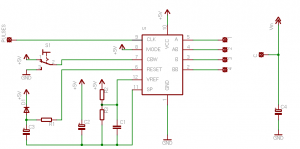
|
 Home Home
 Projects Projects
 Experiments Experiments
 Circuits Circuits
 Theory Theory
 BLOG BLOG
 PIC Tutorials PIC Tutorials
 Time for Science Time for Science
|
| ||
|
28 August 2010 Author: Giorgos Lazaridis Full and Half Stepper Motor Controller with the Sanyo STK672-110A few days ago, i presented a Microstepping Driver with the Sanyo STK672-080. I found this STK672 from an old photocopy machine that i hacked. From the same source, i found a smaller hybrid chip again from Sanyo, the STK672-110. This chip has no microstepping mode and also has some less capabilities than the 080, yet it is very flexible and compact for full and half wave stepper motor applications. The Circuit Here is the circuit, as per the chip's datasheet: 
S1 controls the rotation direction of the motor. The reset circuit (R1-D1-C3) is as described by the manufacturer of the chip. You can use this input (Pin 6) for making resets other ways, like for example if you plan to control the chip with a microcontroller. In this case, you need to know that you must make a 10msec reset, every time that the chip is powered for the first time. From the "MODE" input you control the type of stepper control. In this circuit, i have the chip connected for half-step. If you change the MODE input from +5 to GND, the circuit will work as a full step motor controller. As for the coils of the motor, you need to connect the common wires of the coils (can be 1 or 2 on a unipolar motor) to the "C" connector, and the other 4 wires to the connectors "1" through "4". Usually, unipolar motors with 5 wires have the outputs in "1-2-C-3-4" row, and with 6 wires goes like "1-2-C-3-4-C" or "C-1-2-C-3-4" but this is can change! This is NOT always the same. You can go with trial and error or by measuring the coils of the motor to find the correct order. Do not forget the C4 capacitor! About C4: In the Bill Of Materials underneath, i describe this capacitor as 220uF 100V... Just playing safe. The chip can handle up to 50V, but this does not mean that cannot handle less. So, if your motor is like 3.3 volts or 5 volts, then a 100V capacitor is just too much. Get a 220uF 16V instead. Just do not be too close, for example, if your motor is powered with 12 Volts, go to 220uF 25 volts better. Electrolytic capacitors make a rather unpleasant noise when they explode... Bill Of Materials Comments
|
|
 Contact Contact
 Forum Forum
 Projects Projects
 Experiments Experiments
 Circuits Circuits
 Theory Theory
 BLOG BLOG
 PIC Tutorials PIC Tutorials
 Time for Science Time for Science
 RSS RSS
Site design: Giorgos Lazaridis © Copyright 2008 Please read the Terms of services and the Privacy policy |